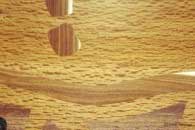|
|
|
Wood properties

Timber’s properties vary enormously
between species and as a result of tree age, stem form, soil
types, climate, latitude, and forest management. Within the
tree, wood properties also vary across the growth rings, with
distance from the pith, and with height up the tree. Wood
properties are also affected by:
• the presence and nature of knots
• pockets of resin or gum
• decay or insect attack
• the pith
• sloping grain
• other anomalies.
Properties of interest to timber users
include durability, colour, density, interesting grain patterns
and workability. Some users may also be interested in wood’s
acoustic properties, electrical conductivity, allergic reactions,
thermal resistance, and surface hardness.
Durability
Natural durability is an important wood
characteristic. In almost all species, the sapwood is highly
susceptible to fungal and insect attack. The heartwood of
many species is durable in ground, above ground, or even under
seawater. In some species the heartwood is particularly resistant
to certain agents such as termites or fungi. For example,
the high silica content of the native Turpentine—Syncarpia
glomulifera—deters marine organisms.
In Australia, timber species are rated
from Class 1 (highly durable) to Class 4 (non-durable). Recent
research suggests that durability is affected by the tree’s
age and the source of the timber. Timber’s ability to
absorb and retain preservative also varies. This makes some
species of low natural durability—for example,
Radiata Pine—ideal
for preservation treatment while many of the more durable
eucalypts cannot be easily impregnated.
Colour
Wood’s colour comes from complex organic compounds deposited
in the heartwood’s cells rather than from its basic structural
components. This is evident from the change in wood colour
that results during the transformation of sapwood to heartwood.
The result is a wide range of wood colours including reds,
blacks, yellows and even purple.
Natural grain, texture and figure
Timber’s display of natural grain,
texture and figure is unique. Texture—either fine or
coarse—is determined by the size of the cells. Grain
may be straight, spiral, sloping, interlocked, curly, wavy
or rippled.
Strength
Timber’s strength and structural performance
are indicated by its stress-grading. The strength of timber
for structural use is described using an F rating that ranges
from F4 to F34. Based on an Australian standard, it provides
an indication of the wood’s bending, tension, shear,
elasticity and compressive strength.
In Australia, kiln dried plantation pine is usually rated
between F5 and F11 depending on the wood’s age and the
presence of knots or other defects. Green Eucalypt timber
is often graded at around F11, but may increase to more than
F17 when dried. The highest F ratings (such as F27) are achieved
by very dense, defect-free dried hardwood timber, such as
Red Ironbark.
Back to top
 |
|
|
|
